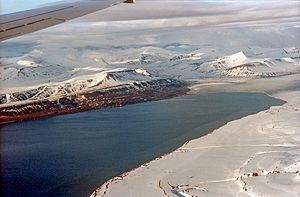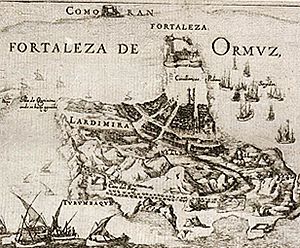Nicholas Woodcock facts for kids
Nicholas Woodcock (born around 1585, possibly died after June 1658) was an English sailor from the 1600s. He traveled to many places, including Spitsbergen (an island group in the Arctic), Virginia in America, and parts of Asia. He was important in the early days of whaling and even helped with big battles at sea.
Contents
Nicholas Woodcock's Adventures
Exploring Spitsbergen: 1610–1618
Nicholas Woodcock might have been related to another person with the same name. That person went on an expedition to the River Ob in 1568. Since the name Woodcock wasn't very common, it's possible they were family.
In 1610, Nicholas Woodcock worked as a mate on a ship called the Amity. This ship, weighing 60 tons, went on a trip to Spitsbergen. They were exploring and hunting seals.
In 1611, Woodcock had a great idea for the Muscovy Company. He suggested they hire six experienced Basque whalers from a town called St Jean de Luz. These whalers knew a lot about hunting whales. The company took his advice. They sent the whalers along with two ships, the Mary Margaret and the Elizabeth, to Spitsbergen. This was the first time ships went to the island specifically to hunt the Greenland right whale.
Woodcock was upset because he wasn't chosen to go on this important trip. So, he joined another ship called the Hopewell.
In 1612, Woodcock became a pilot for the first Spanish whaling ship. It sailed from San Sebastián to Spitsbergen. Even though he was put in prison for 16 months for helping the Spanish, his trip was a big success! Because of this, many more ships from the Basque country and northern France sailed to Spitsbergen the next year.
Woodcock returned to whaling in 1614. He had to work for the Muscovy Company, which now had special rights to the whaling trade. He was the master of a ship called the Prosperous. They went to places like Sir Thomas Smith Bay and Cross Road. At Cross Road, he even set up a temporary station for whaling.
In 1617, Danish records mention Woodcock as the master of an English ship in Green Harbor (Grønfjorden). His last known visit to Spitsbergen was in 1618. At that time, he was the master of a ship called the Sea Horse.
Adventures with the East India Company: 1621–1623
In 1622, Woodcock was part of some big battles. He was with the English and Persian forces when they attacked Kishm and then laid siege to Ormus. Woodcock was the master of a ship called the Whale. This ship was the second most important ship in the English fleet of nine vessels.
Later, Woodcock was accused of taking some valuable items from Ormus. He strongly denied it, but in November 1624, he was found responsible.
A traveler named Pietro Della Valle wrote about Woodcock. Della Valle sailed with Woodcock on the Whale from Bandar Abbas to Surat in January 1623. Della Valle said that Woodcock had spent over a year in the Persian Gulf. He was making maps of the Strait of Hormuz and nearby areas to find good places for ships to anchor.
On January 22, Woodcock showed Della Valle something interesting. He thought it was a piece of unicorn horn. But it was actually a piece of a narwhal tusk! He had found it in Greenland (Spitsbergen) in 1611. Woodcock proudly said he was the first Christian to name and discover Greenland in the same year he found the "horn."
In March, Woodcock's ship, the Whale, was lost between Surat and Daman. Many of the crew drowned, including Woodcock's son, Richard. Woodcock also lost everything he owned. Some people thought Woodcock had caused the ship to sink by taking out too much weight and putting too much cargo on board.
Woodcock was in England from 1624 to 1626. In November 1626, he asked to be cleared of the accusations. The court agreed, and he was set free. In May 1635, he was the master of a ship called the Revenge of London. This ship carried tobacco, animal skins, and other goods from Virginia. At that time, he was said to be about 50 years old and lived in Wapping, Middlesex.
Nicholas Woodcock's Impact
Woodcock was a very important person in the early days of whaling in Spitsbergen. He was the one who suggested bringing Basque whalers for the first whaling trip to Spitsbergen in 1611. The next year, he led the very first Basque ship to Spitsbergen.
The success of that trip led to a huge increase in whaling in Spitsbergen. Because of Woodcock's idea, Basque experts were hired not only by the English but also by the Dutch, French, and Danish. Everyone relied on these Basque experts when the Spitsbergen whaling industry first started.



